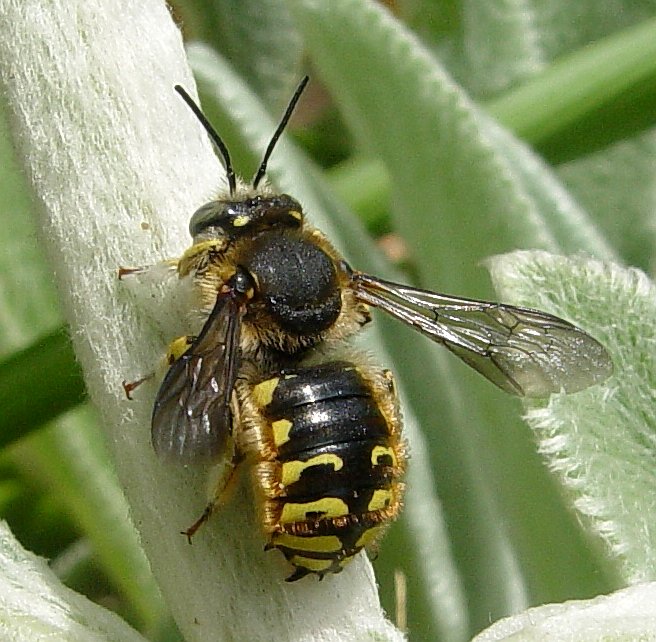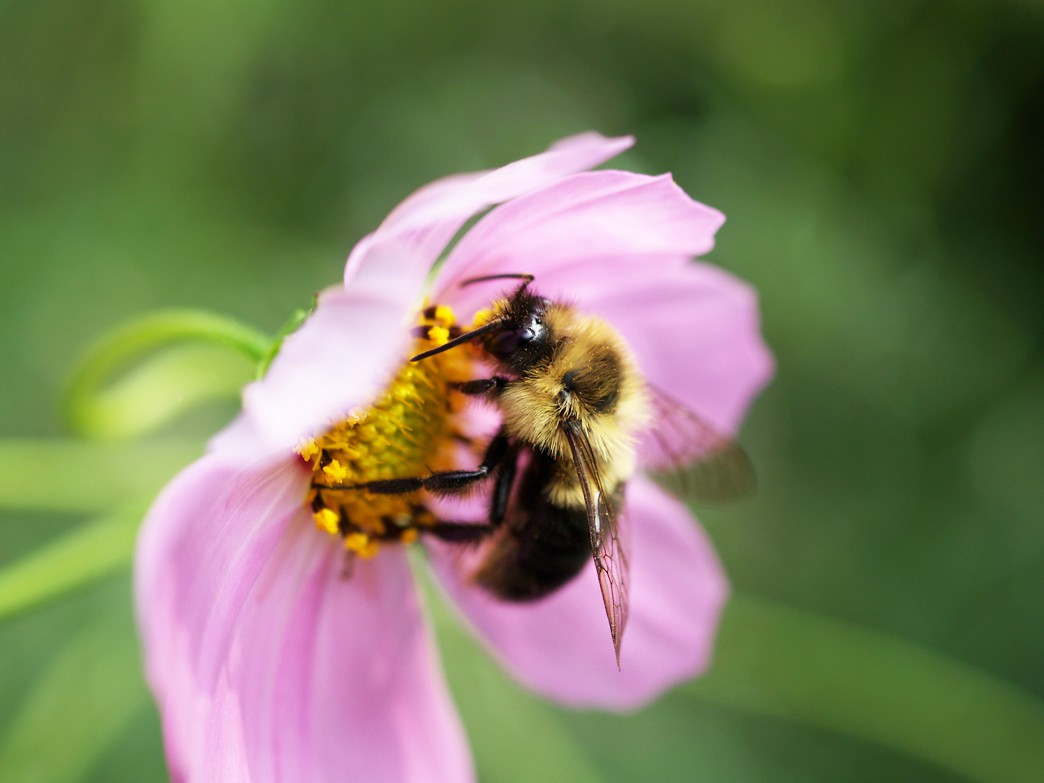Project Results
I'm so excited to share our recent publication highlighting the work you helped fund. We found that bumble bees will avoid foraging for food near wool-carder bees. But luckily, we found no effects of this avoidance behavior on bumble bee fitness (reproduction or growth). Thank you again for supporting this work!
Anthidium manicatum, an invasive bee, excludes a native bumble bee, Bombus impatiens, from floral resources
Kelsey K. Graham, Katherine Eaton, Isabel Obrien, Philip T. Starks
About This Project
Is a recently introduced invasive species, the European wool-carder bee, threatening our native bumble bees?
Male wool-carder bees use evolved weapons on the base of their abdomen to ram into bumble bees trying to gain access to flowers. This project will determine if these interactions are hurting bumble bee lifetime reproductive success.
Ask the Scientists
Join The DiscussionWhat is the context of this research?
Invasive species dramatically reshape their invaded landscapes and restructure interactions between native species. In North America, the European wool-carder bee (Anthidium manicatum), a recently introduced non-native species, threatens the well-being of native bees.
Male wool-carder bees defend patches of flowers using evolved weapons on the base of their abdomen to ram into other bees trying to visit the defended flowers. And the cost of these interactions to other bees is high - often severe injury or even death. Of our native bees, bumble bees receive the majority of attacks from wool-carder bees. Yet we do not know the impact of these attacks on bumble bee populations.
What is the significance of this project?
Bumble bees are declining drastically. Some previously common species are estimated to have only 4% of their original population surviving today. We depend on bumble bees to pollinate crops – including tomatoes, peppers, blueberries, and more. Bumble bees perform a special pollination behavior called buzz pollination, which many native crops depend on. Without bumble bees, the sustainability of US agriculture would be in question.
The greatest threat to bumble bees is habitat destruction - urbanization, agriculture and introduction of invasive species, such as the wool-carder bee. Yet we don't know the extent of impact wool-carder bees have on bumble bee decline. Therefore, my research will determine long term effects of wool-carder bees on bumble bees.
Projects such as this are necessary to determine the impact of this invasive bee on our native ecosystem. With the information provided by this project, we can make recommendations about wool-carder bee control and ecosystem rehabilitation.
What are the goals of the project?
My previous research determined that bumble bees actively avoid visiting flowers near wool-carder bees. But we need to establish if wool-carder bees will have long term fitness effects on bumble bees. To do this I will measure fitness in the following ways:
- Use 12 screened enclosures filled with flowers to subject 12 bumble bee hives to 2 treatments – enclosures with wool-carder bees, and enclosures without wool-carder bees (controls)
- Measure bumble bee hive growth over the season (weekly weight of hives)
- Perform bumble bee demographics (number and size of bees, and number of future queens) at the end of the season
Budget
I need your support to make this research possible. While my previous research showed that bumble bees are negatively affected by wool-carder bees, I have yet to establish direct fitness consequences. With your help, I will determine if the presence of wool-carder bees threaten the long-term viability of bumble bees.
This information will be used to better inform management decisions. If negative fitness effects are found in bumble bees, active management of wool-carder bees will be recommended to limit their impact on our already troubled native bees.
Your support will allow me to purchase bumble bee (B. impatiens) hives and additional screened enclosures for my field site. These enclosures will allow me to manipulate the encounter rate of bumble bees and wool-carder bees. Half the hives will forage in enclosures with wool-carder bees while the other half serve as controls (no wool-carder bees). Data will be collected over 8 weeks between July and September.
STRETCH GOAL: +$500
Thank you so much to all of my backers! I've successfully reached my funding goal, and would love to attain my new reach goal. Research conferences are really important for spreading the word about my research and learning about what other researchers are up to. I've added the goal of $500 to help me attend a conference and present on my findings. Thank you!!
Endorsed by
Meet the Team
Team Bio
I'm a fourth year PhD student in the biology department at Tufts University. I'm fascinated by animal behavior and what makes some species so successful at invading new habitats. When I'm not chasing after bees, you can find me playing ultimate frisbee or otherwise enjoying the great outdoors.
Kelsey K Graham
I'm a behavioral ecologist interested in how invasive species impact our native ecosystem. My research falls at the crossroads of animal behavior and invasion ecology. I currently am interested in how a recent bee invader, the European wool-carder bee, is impacting our native bees and plants. Follow me on twitter and instagram @woolcarderbee
Additional Information

Male wool-carder bee, Photo credit: Ilona L

Bumble bee, Photo credit: eskimo_jo

Screened enclosures at Tufts field site
Video credits:
Editor - Jack Wolfe
Voice over - Jen Mortensen
Picture credits - Wild flowers, Photo credit: Dana Voss; Wool carder bee yellow snapdragon, Photo credit: Patty O'Hearn Kickham; Anthidium manicatum map, discoverlife.org; Wool Carder Bee, P8230120, Photo credit: Anita Gould; Wool carder bee in flight, Photo credit: Jim Webber; Anthidium manicatum – European wool-carder bee – male, Photo credit: Ilona L; Bee on cone flower, Photo credit: John Flannery; Produce market, Photo credit: Patrick Feller; Flowers, Photo credit: Domenico Salvagnin; Intact, Photo credit: Mr. E?; Bumble bees, Photo credit: bamble_; Bombus impatiens on Lysimachia clethroides, Photo credit: Dan Nydick
Project Backers
- 44Backers
- 130%Funded
- $2,600Total Donations
- $54.55Average Donation



